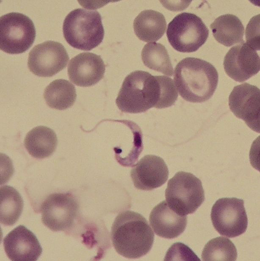The pathogen: The unicellular protozoan Trypanosoma cruzi, surrounded by red blood cells. Source: Division of Infectious Diseases and Tropical Medicine, LMU Medical Center
How does one combat a tropical disease when most of those infected are unaware that they carry the pathogen responsible? How can one reach, test and treat the population at risk? A pilot study by LMU researchers suggests possible answers.
Chagas disease is caused by the unicellular protozoan parasite Trypanosoma cruzi, which is endemic to many parts of Latin America. It is estimated that somewhere between 6 and 7 million people around the world harbor the parasite, and over 10,000 people succumb to the disease every year. In areas where the disease is endemic, the parasite is transmitted mainly by insect vectors, principally blood-sucking bugs. The World Health Organization (WHO) classifies Chagas as a neglected tropical disease. The acute phase of the disease is accompanied by rather non-specific symptoms, which explains why many people who have been infected are unaware of the fact. In the absence of effective treatment, however, the disease evolves into an asymptomatic and lifelong chronic phase. In about 30% of cases this leads—years or even decades after the initial infection—to dysfunction of multiple organs, involving, in particular, the nervous system, the heart, and the esophagus and the gastrointestinal system.
In light of the increase in international mobility, a German-Spanish team led by Dr. Michael Pritsch and Professor Michael Hölscher of the Division of Infectious Diseases and Tropical Medicine at the LMU Medical Center has now carried out a pilot study with a view to assessing the epidemiological situation of Chagas disease among citizens of Bolivian origin living in Munich and its implications for healthcare services. The findings appear in BMJ Open, the open-access edition of the British Medical Journal.
Chagas disease is endemic to more than 20 countries in Latin America, of which Bolivia is by far the most seriously affected. In the study, the Munich researchers interviewed and examined 43 individuals with Bolivian roots, most of whom have resided in Germany for years, and approximately half of whom were born here. Four of these persons (9.3%) were found to be infected with T. cruzi. This rate of infection is lower than that recorded in comparable studies of Bolivian migrants elsewhere in Europe, e.g. in Spain, but the authors point out that the sample size is not large enough to be representative. Nevertheless, the researchers view the prevalence of infection among the study population as "alarming," not least because monitoring and treatment of the disease pose a considerable challenge to the German healthcare system, which they believe it is inadequately prepared to meet.
Virtually none of the study population had previously been tested for T. cruzi, and most of them knew little about the disease itself, the risks associated with its progression or the ways in which it can be transmitted. In the absence of its natural vector, the main routes for transmission of the pathogen are via contaminated blood products or in the course of organ transplantations, and by passage from mother to child during pregnancy. In fact, a mother and her daughter were among the four seropositive individuals detected in the study—which suggests that congenital transmission had occurred in this case.
Given the prevalence of the disease among the study population, the authors call on the German public health authorities to intensify their efforts to reach Bolivian migrants German healthcare system. They suggest that campaigns to disseminate information on the disease should be undertaken, in cooperation with migrant communities from countries in which the disease is endemic—with a view to reaching undocumented migrants who lack valid residency permits, and are therefore particularly at risk. Given that epidemiological data relating to Chagas disease in Germany are extremely patchy, the ability to control of the potential for transmission of the disease is severely compromised. The researchers therefore urge that steps be taken to improve monitoring of the condition. Blood donors are routinely asked whether or not they have or have had any of a number of parasitic infections, and Chagas is among the diseases listed in the questionnaire, and people who have visited countries known to harbor the parasite are excluded from giving blood for 6 months after their return. However, there are no guidelines for testing groups already at risk, and pregnant women who come from endemic areas are not routinely tested for the presence of the parasite. The authors of the study hope that the measures they suggest will lead to the discovery of further cases of infection and to successful treatment of the victims and asymptomatic carriers. In this way, the risk that the pathogen might be non-vectorially transmitted in Germany could be significantly reduced.
More information: Miriam Navarro et al. Cross-sectional, descriptive study of Chagas disease among citizens of Bolivian origin living in Munich, Germany, BMJ Open (2017). DOI: 10.1136/bmjopen-2016-013960
Journal information: BMJ Open , British Medical Journal (BMJ)
Provided by Ludwig Maximilian University of Munich




















